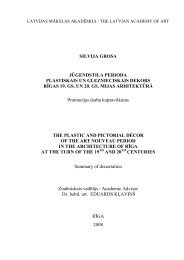Institute of Art History of the Latvian Academy of Art Anna Ancāne ...
Institute of Art History of the Latvian Academy of Art Anna Ancāne ...
Institute of Art History of the Latvian Academy of Art Anna Ancāne ...
Create successful ePaper yourself
Turn your PDF publications into a flip-book with our unique Google optimized e-Paper software.
mentioned ones. The strategic meaning <strong>of</strong> Šķūņu – Skārņu Street line<br />
diminished. Over <strong>the</strong> next 100 years Kaļķu, Grēcinieku, Kungu and<br />
Mārstaļu Streets were established as <strong>the</strong> widest avenues in this part <strong>of</strong> <strong>the</strong><br />
town. As a result <strong>of</strong> functional changes, <strong>the</strong> main arteries and spatial<br />
landmarks <strong>of</strong> urban structure were formed, still evident in <strong>the</strong> early 20 th<br />
century until <strong>the</strong> spatial links between <strong>the</strong> inner town and Daugava<br />
Riverbank had remained in place. In <strong>the</strong> town’s oldest core <strong>the</strong> ancient<br />
boundaries <strong>of</strong> quarters with concentric streets were preserved.<br />
II. 2. Innovations in Riga’s fortification system and related changes<br />
in <strong>the</strong> structure <strong>of</strong> urban planning<br />
2.1. Insight into <strong>the</strong> innovations <strong>of</strong> fortifications in <strong>the</strong> 17 th century<br />
Europe<br />
In <strong>the</strong> 17 th century two most wide-spread fortification systems were in<br />
use: in <strong>the</strong> 1 st half <strong>of</strong> <strong>the</strong> century <strong>the</strong> Old Dutch style prevailed with land<br />
fortifications and a complex system <strong>of</strong> water ditches, <strong>the</strong>n <strong>the</strong> French<br />
system developed in <strong>the</strong> 2 nd half <strong>of</strong> <strong>the</strong> century, with <strong>the</strong> stone<br />
fortifications and an improved front <strong>of</strong> bastions. Fortifications were<br />
greatly improved by <strong>the</strong> most prominent 17 th century French fortification<br />
specialist Sébastien Le Prestre de Vauban, Dutch Lieutenant-General<br />
Menno van Coehoorn and German war engineer Georg Rimpler. Vauban<br />
was most influential on <strong>the</strong> international scale, including Nor<strong>the</strong>rn<br />
Europe.<br />
2.2. 1 st reconstruction period <strong>of</strong> Riga’s fortifications<br />
In <strong>the</strong> 1 st half <strong>of</strong> <strong>the</strong> 17 th century wide-scale renovation <strong>of</strong> fortifications<br />
started in Riga. Two periods <strong>of</strong> rise are evident – in <strong>the</strong> 1650s and 1680s<br />
– 1690s; <strong>the</strong> first period syn<strong>the</strong>sised Dutch latest achievements, <strong>the</strong><br />
second – French ones. Since 1632 works on Riga’s fortifications were<br />
supervised by <strong>the</strong> military engineer Heinrich Thomé but in 1650<br />
Franciscus Murrer worked out <strong>the</strong> modernisation project <strong>of</strong> fortifications<br />
for Riga town and suburbs with bastions. The same year <strong>the</strong> innovative<br />
project for Riga’s suburbs and fortifications with 13 bastions and a water<br />
ditch by Johann van Rodenburgh appeared. The project envisaged regular<br />
districts and a street network as well as digging two parallel canals joined<br />
with <strong>the</strong> River Daugava. Rodenburgh’s project complied with <strong>the</strong> Old<br />
Dutch system <strong>of</strong> defence promoted by <strong>the</strong> Leyden University, an<br />
important centre <strong>of</strong> fortification and urban planning, Pr<strong>of</strong>essor Nicolaus<br />
Goldmann’s lectures and <strong>the</strong> work La nouvelle fortification was<br />
especially significant.<br />
2.3. The idea <strong>of</strong> ideal plan in Riga’s urban planning in <strong>the</strong> mid-17 th<br />
century<br />
Searching for a composition that would unite different urban districts was<br />
common: real or utopian plans <strong>of</strong> knitting toge<strong>the</strong>r <strong>the</strong> new street network<br />
and <strong>the</strong> old one abounded (examples – Harlem, Groningen, Utrecht).<br />
8












